»Frauen haben ihre Kinder, die sie nicht mehr tragen konnten, am Wege liegen lassen. Auch sie wurden erschossen, wie überhaupt alles ›umgelegt‹ wird, was wegen Krankheit, Alter und Schwäche nicht mehr weiter kann.«
Osaritschi
Die Sterbelager
Osaritschi, 3. Juli 1997: Treffen von ehemaligen Häftlingen vor dem neuen Denkmal aus dem Jahr 1994
Belorusskij gosudarstwennyj muzej istorii Welikoj Otetschestwennoj wojny, Minsk
Bei ihrem Rückzug im Frühjahr 1944 treibt die deutsche Wehrmacht Zehntausende Zivilisten vor sich her. Anfang März richtet die 9. deutsche Armee der Heeresgruppe Mitte unter Oberbefehlshaber Josef Harpe (1887–1968) drei mit Stacheldraht umzäunte Notlager in einem Sumpfgebiet nahe der Dörfer Osaritschi, Dert und Podosinnik südöstlich von Minsk ein. Erklärtes Ziel ist es, »Seuchenkranke, Krüppel, Greise und Frauen mit mehr als zwei Kindern unter zehn Jahren sowie sonstige Arbeitsunfähige« loszuwerden. Die 35. Infanteriedivision unter General Georg Richert (1890–1946) und das Sonderkommando 7 a der SS-Einsatzgruppe B treiben zwischen dem 12. und dem 16. März etwa 50.000 erschöpfte und hilflose Zivilisten dorthin.
Bis zum Einmarsch der 65. Armee der 1. Belorussischen Front am 17. März 1944 kommen – unter freiem Himmel, ohne Wasser und ohne Nahrung – zwischen 9.000 und 13.000 Kinder, Frauen und Männer um. Dieses kalkulierte Massensterben durch Fleckfieber, Hunger und Kälte gilt als eines der schwersten Verbrechen der Wehrmacht gegen Zivilisten im Zweiten Weltkrieg.
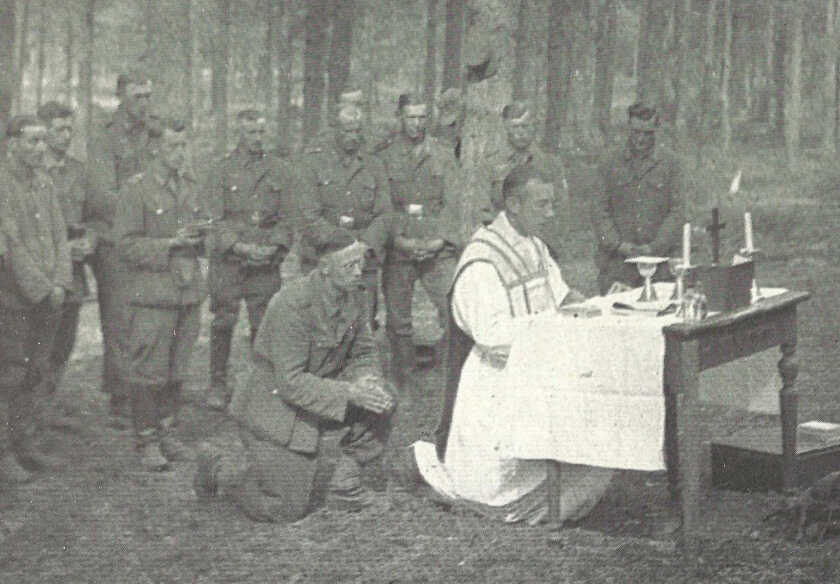
Josef Prerau bei einem Feldgottesdienst. Er veröffentlicht 1962 sein Buch »Priester im Heere Hitlers. Erinnerungen 1940–1945«.
gemeinfrei
Josef Perau (1910–2004), Feldgeistlicher der 129. Infanteriedivision und Augenzeuge
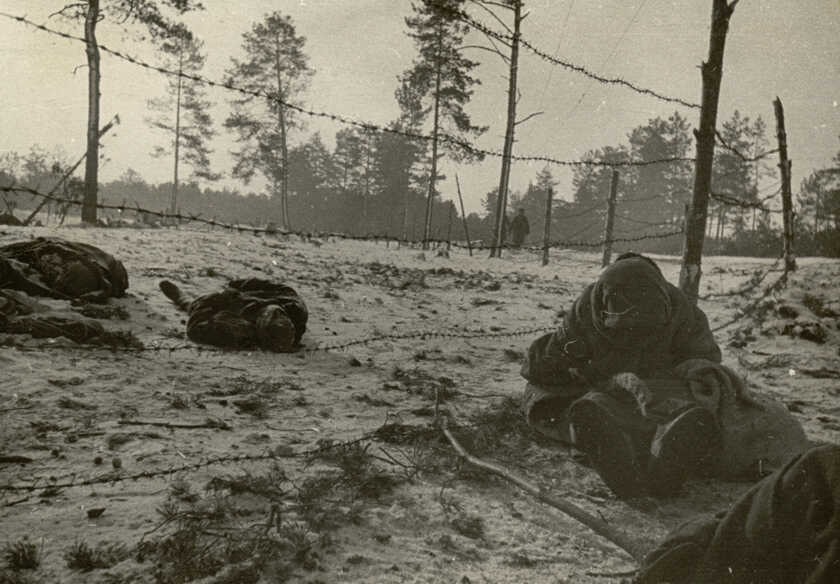
Osaritschi, 18. März 1944: die Begrenzung des Lagers mit Opfern des Minengürtels
Aufnahme: Podschiwalow
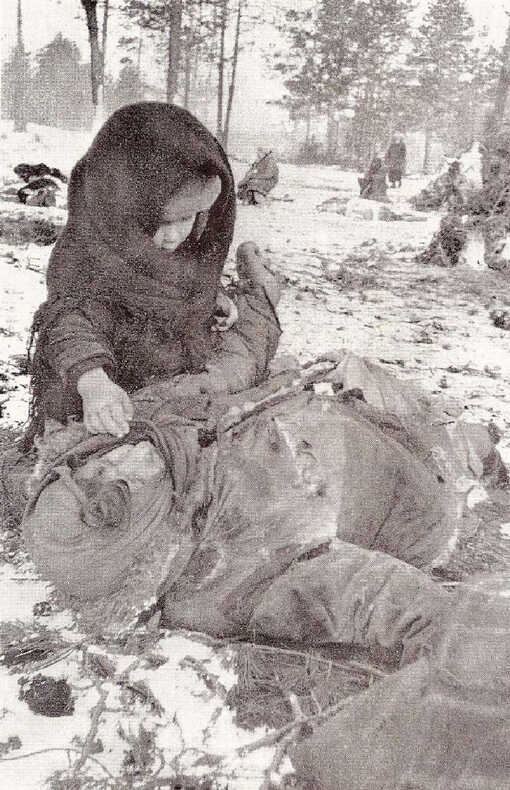
Osaritschi, 18. März 1944: die dreijährige Tanja mit ihrer toten Mutter
Aufnahme: Podschiwalow
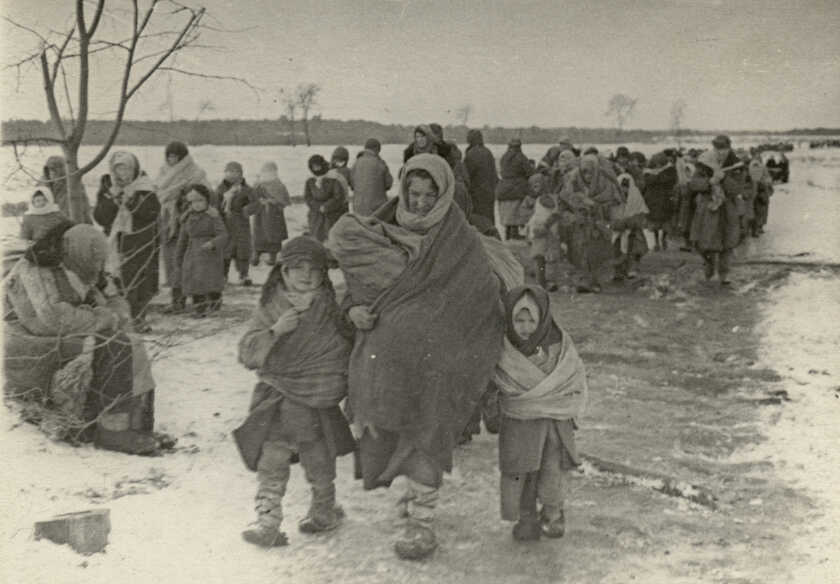
Marija Makarowa Rytschankowa aus dem Dorf Wiritschew mit ihren drei Kindern auf dem Weg in die Siedlung Osaritschi am 19. März 1944; v. l. n. r.: Iwan (*1937), die zweijährige Fenja, die am 23. März, und die vierjährige Anja, die am 29. März an den Folgen der Haft versterben
Alperin

Osaritschi, 19. März 1944: Wassilij Gorban aus Podwiki, Polessje-Gebiet, beerdigt seinen einzigen Enkel, den anderthalbjährigen Wowa, der verhungert ist
Aufnahme: Alperin
NACH DER BEFREIUNG
Bereits unmittelbar nach der Rückeroberung durch die Rote Armee beginnt die Außerordentliche Kommission mit der Beweissicherung in Osaritschi, Dert und Podosinnik. Ihre Untersuchungsergebnisse dienen der antideutschen Kriegspropaganda und 1945/46 als Beweisdokument beim Nürnberger Kriegsverbrecherprozess. General Richert wird im Minsker Prozess wegen seiner Beteiligung an den Todeslagern um Osaritschi zum Tode verurteilt und am 30. Januar 1946 auf der Pferderennbahn gehenkt. Die Hauptschuldigen bleiben allerdings unbehelligt. 1965 entsteht ein Denkmal am historischen Ort, dennoch werden die Opfer in der Sowjetunion kaum öffentlich gewürdigt. Erst in der unabhängigen Republik Belarus können sie über ihre Erlebnisse berichten. 1994 wird ein neues Denkmal eingeweiht. Nach und nach wird es um ein kleines Museum und eine russisch-orthodoxe Kapelle ergänzt.
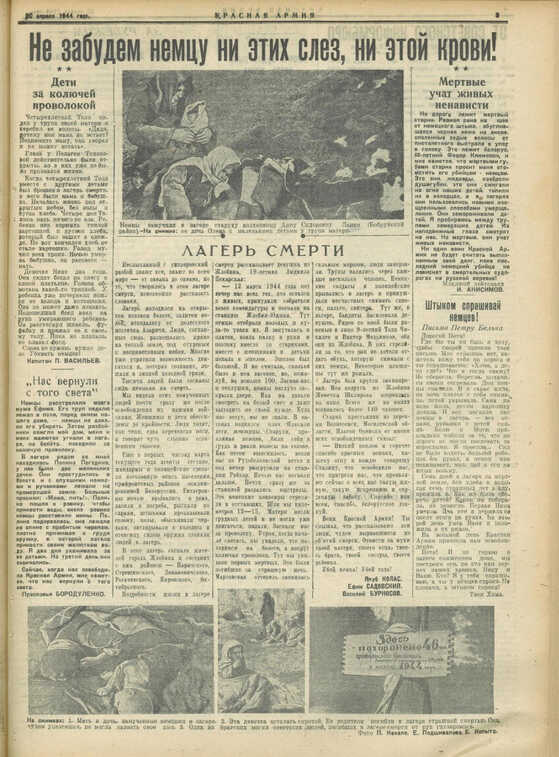
Seite 3 der Tageszeitung Rote Armee vom 20. April 1944 mit einem Bericht über das »Todesslager« in Osaritschi unter Überschrift: »Wir vergessen dem Deutschen keine Träne, keinen Tropfen Bluts!«
Krasnaja Armija / Zeitungsabteilung der Staatsbibliothek zu Berlin Preußischer Kulturbesitz
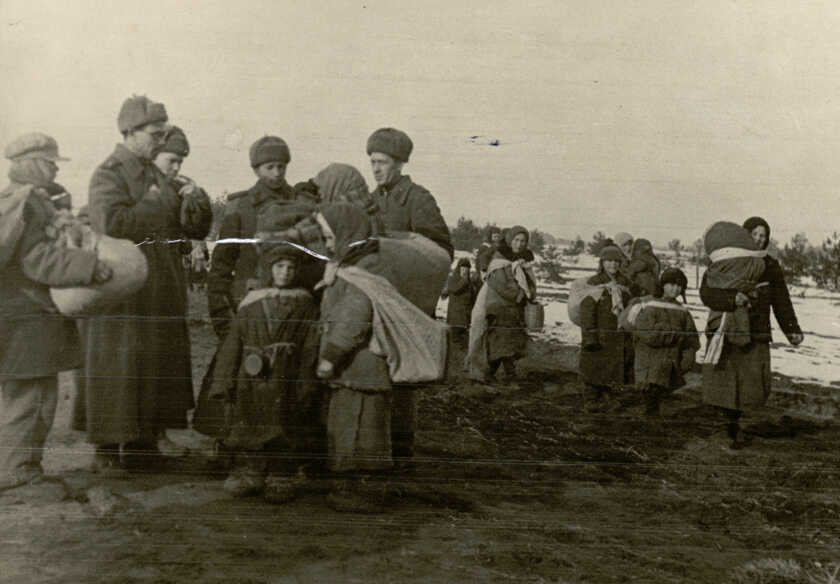
Überlebende sprechen mit Offizieren und Soldaten der Roten Armee.
Belorusskij Gosudarstvennyj Muzej Istorii Velikoj Otechestvennoj Vojny Minsk
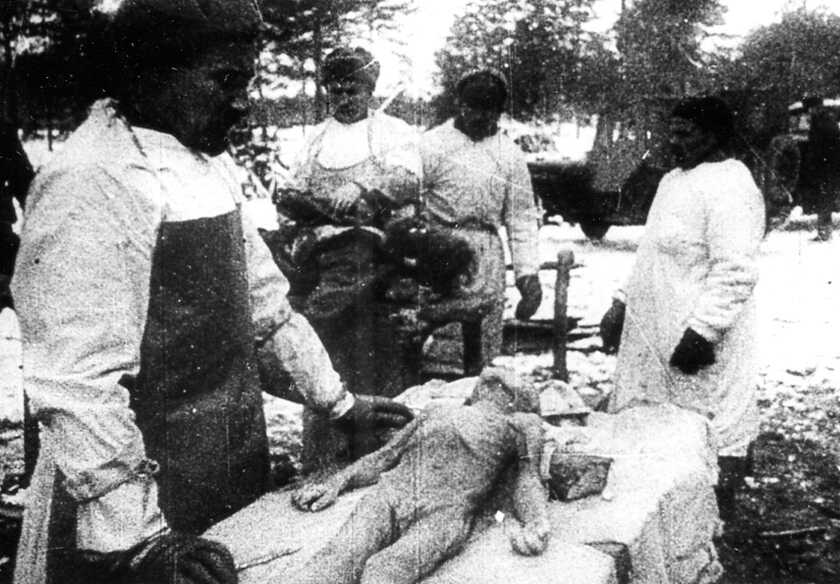
Angehörige der Außerordentlichen Kommission bei der Arbeit. Standbild aus dem Kinofilm
Die Befreiung Sowjetbelorusslands von den deutsch-faschistischen Okkupanten.
Walentina Schischlo
1936
Walentina Schischlo Ende der 1940er Jahre
Privatbesitz Familie Schischlo
Walentina Schischlo wird am 10. Februar 1936 im Dorf Beliza bei Schlobin geboren. Ihr Vater ist Offizier der Roten Armee und gerät bereits 1941 in deutsche Gefangenschaft. Während der Besatzung lebt die Familie in Beliza bei dessen Eltern. 1943 werden sie gezwungen, in einem Pferdestall zu hausen. Neben Einheimischen sind dort auch Zivilisten untergebracht, die aus Smolensk vertrieben worden waren.
Walentina ist acht Jahre alt, als sie im März 1944 zusammen mit ihrer Mutter Nina Danilowa und ihren vier Geschwistern von der Wehrmacht in das Lager bei Osaritschi verschleppt wird. Die Familie ist mehrere Tage unterwegs und muss dabei im Freien übernachten. Drei jüngere Brüder, Garik, Marat und Boris, kommen im Lager um. Walentina und ihre Schwester Klara überleben dank der Großmutter Warwara, die die Kinder auf den Schafspelz eines Toten bettet. Dennoch erkrankt Walentina an Typhus und muss nach der Befreiung in einem Lazarett behandelt werden.
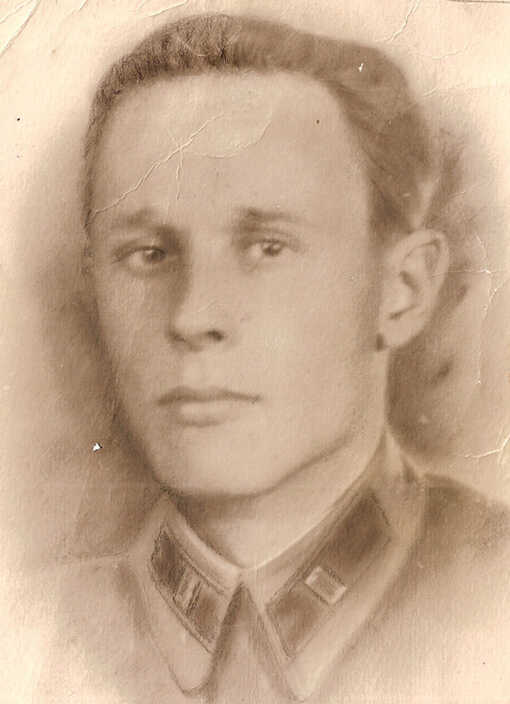
Walentinas Vater Fjodor Danilow, 1941. Als Gefangener kommt er ins Konzentrationslager Dachau und wird auf dem SS-Schießplatz Hebertshausen ermordet.
Privatbesitz Familie Schischlo
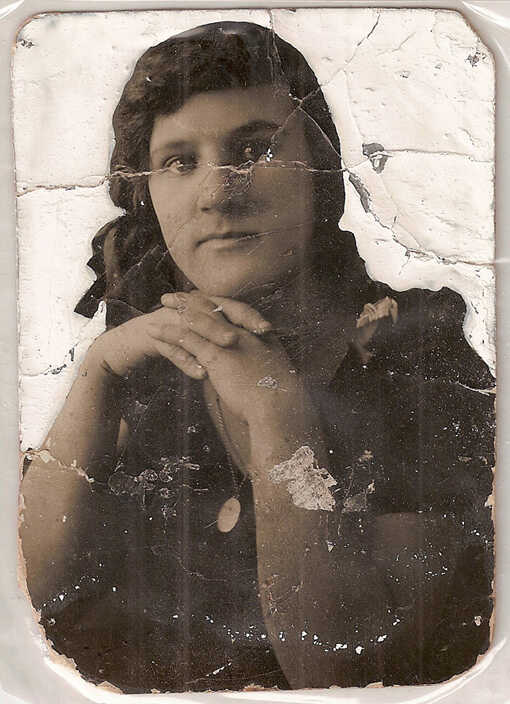
Walentinas Mutter Nina Danilowa, 1937
Privatbesitz Familie Schischlo
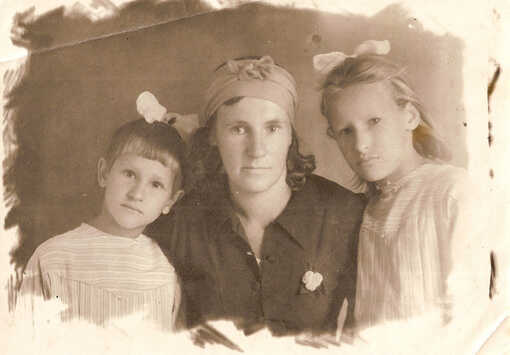
Walentina mit ihrer Mutter Nina und Schwester Klara (v. l. n. r.), Ende der 1940er Jahre.
Privatbesitz Familie Schischlo
»Wir starben einfach einen furchtbaren Tod. Das waren Hunger, Kälte und Typhus.«
»Am Morgen hat uns keiner geweckt, die Hunde bellen nicht, es ist kein Laut zu hören und langsam heben alle den Kopf, wer noch kann, steht auf. Da kommen sie, unsere Retter. Oh, wie vielen Menschen es das Leben kostet, denn alle stürzen ihnen [den Soldaten] entgegen. Und sie rufen: ›Bleibt da, rührt euch nicht vom Fleck […] die haben ja das ganze Lager vermint.‹«
Gespräch mit Walentina Schischlo am 21. Dezember 2018 in Minsk
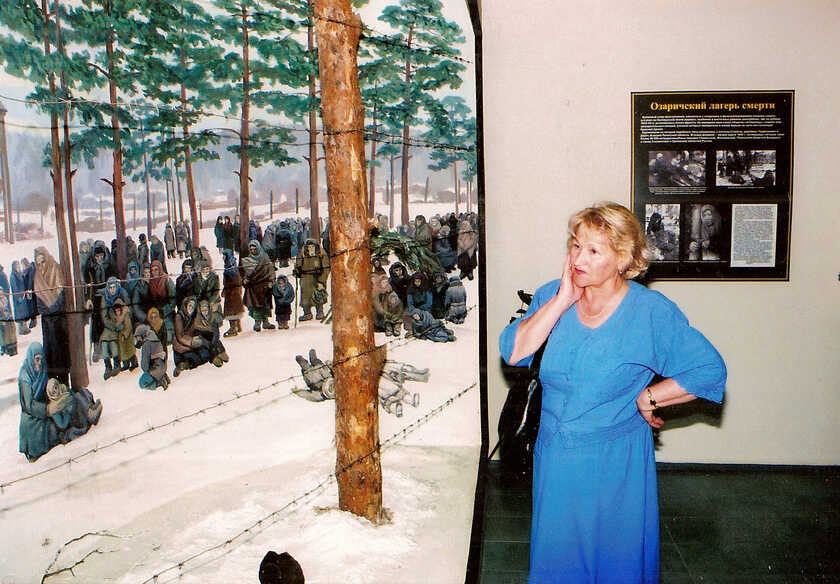
Walentina Schischlo im Museum in Osaritschi, 1990er Jahre. Die gelernte Technologin vermittelt seit Jahrzehnten ihre Erlebnisse als Zeitzeugin. Seit 2010 leitet sie den Ortsverein der Osaritschi-Überlebenden in Minsk.
Privatbesitz Familie Schischlo

